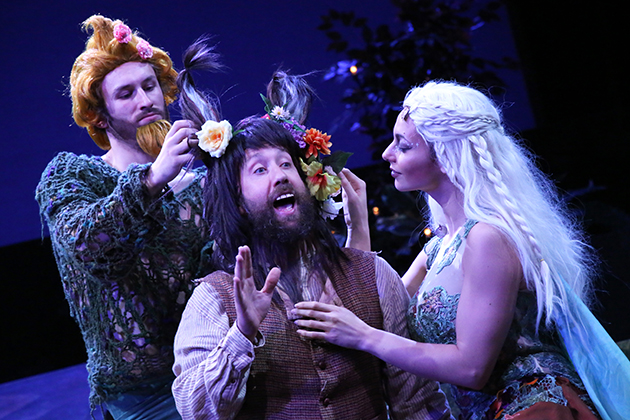
Shakespeare’s comedy “A Midsummer Night’s Dream,” which opens today as the final production of the spring season of the Connecticut Repertory Theatre, is among the Bard’s most popular works. But it was not always so revered.
The play, written circa 1590, is a comedy of mistaken love set in a forest with fairies, magic spells, and people transforming into animals. Almost a century later, during The Restoration of the English monarchy, production of the play fell out of favor.
“It was seen as frivolous and silly,” says Lindsay Cummings, assistant professor of theatre studies in the School of Fine Arts. “It was also too ensemble driven. There was no star role in a period where you had the rise of actor/manager-driven companies. No one wants to pick this play because it’s hard to say: who’s the starring character?”
However, by the dawn of the 19th century, she says, the rise of the Romantic Movement in literature embraced the themes of “A Midsummer Night’s Dream.” At the same time, the roles of both director and set designer begin to rise in the theater.

“When the play becomes popular again, it’s both thematically interesting to people and the early new productions were clearly less about starring roles and more about this new thing, which is the director’s vision or a design,” Cummings says. “That’s where this play latched on and became popular, because it is theatrical; it is spectacular. Once we stop doing the bare Shakespearian stage, we can embrace that spectacle. Suddenly it’s really exciting.”
The resurgence of interest in the comedy resulted in adaptations of “Midsummer” in several forms, as a musical, operetta, opera, and ballet. As technology advanced, the production moved from the stage to film and television, with the ongoing challenge of creating new ways to visualize the mystery and magic of the forest and its inhabitants, particularly the imaginative fairies.

Cummings notes that one of the early innovators was the 1856 Charles Kean production that had the character Puck arrive on stage by appearing on the cap of a mushroom rising from the stage floor. At the turn of the century, Sir Herbert Beerbohm Tree created a forest on stage with full trees, real grass, and live rabbits. In the 20th century, the award-winning director Peter Brook presented a spare, white box as the setting and had actors doing circus moves to create theatrical magic.
“It’s about how we make that magic new and exciting,” she says. “That’s where people have the most fun with this show. It’s a show about theater. It’s a play with a play in it. It’s the inherent theatricality.”
A Director’s Vision
The CRT production is directed by Dale AJ Rose, associate artistic director at CRT and director of performance studies, who has set “Midsummer” at the dawn of the 20th century, as electricity began to change the world. Rose says his influences for creating the fairy world in the CRT production originate from Andrew Lang’s 12-volume Fairy Books of Many Colors, published between 1889 and 1910, and John Crowley’s 1981 fantasy novel Little, Big.
“I have never thought of this world as delicate, but a world that has power over the natural order of things,” Rose says. “In this production I also see the industrial world as bringing about the end of the Fairy Kingdom. Once mankind finds a scientific way of producing light, the dark, which is the fairies’ world, is threatened and will bring about their demise. This does parallel the inventions of man – seemingly for the good of mankind – that have caused the destruction of many elements of good in the natural world.”
Michael Demers, CRT’s master stage electrician, says creating theatrical magic on stage for any production is challenging, noting that today’s audiences arrive having seen so many special effects in films. His goal is to fulfill the director’s vision.
“The first part is believing you can do it,” Demers says of his approach to meeting the challenges. “The next thing is to go ahead and leave it open to whoever is going to come up with the right idea. Every show, we’re prototyping something. I don’t really worry very much if I hit it out of the park the first time. I just want to get something to have comments on quickly.”
In “Midsummer,” the changing light from the phases of the moon is symbolic and plays a role in the storyline. There are also other illuminations of trees and flowers in the forest. Demers says one of the technical decisions needed was how to accomplish the changes.
“There are a number of ways you can do that. You can do one moon and light it in a number of ways so the light catches it, or you can have different [moons] that come in,” he says.
“There are all types of lighting throughout. There are glowing flowers, a tree that has lights integrated. The special effects allow for different glimpses into how things can be perceived. We use dry ice to allow for low lying fog in the forest that provides that mystery of what’s under your feet.”
“A Midsummer Night’s Dream” is at the Harriet S. Jorgensen Theatre in the Jorgensen Center for the Performing Arts from April 23 through May 3. For information go to the CRT website.


